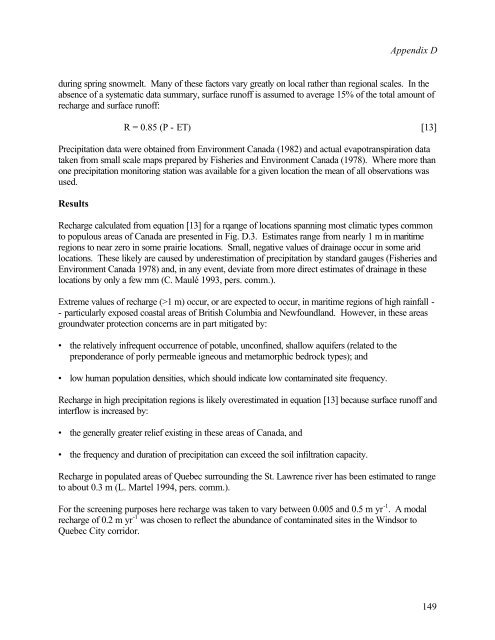Protocol for the Derivation of Environmental and Human ... - CCME
Protocol for the Derivation of Environmental and Human ... - CCME
Protocol for the Derivation of Environmental and Human ... - CCME
Create successful ePaper yourself
Turn your PDF publications into a flip-book with our unique Google optimized e-Paper software.
Appendix D<br />
during spring snowmelt. Many <strong>of</strong> <strong>the</strong>se factors vary greatly on local ra<strong>the</strong>r than regional scales. In <strong>the</strong><br />
absence <strong>of</strong> a systematic data summary, surface run<strong>of</strong>f is assumed to average 15% <strong>of</strong> <strong>the</strong> total amount <strong>of</strong><br />
recharge <strong>and</strong> surface run<strong>of</strong>f:<br />
R = 0.85 (P - ET) [13]<br />
Precipitation data were obtained from Environment Canada (1982) <strong>and</strong> actual evapotranspiration data<br />
taken from small scale maps prepared by Fisheries <strong>and</strong> Environment Canada (1978). Where more than<br />
one precipitation monitoring station was available <strong>for</strong> a given location <strong>the</strong> mean <strong>of</strong> all observations was<br />
used.<br />
Results<br />
Recharge calculated from equation [13] <strong>for</strong> a rqange <strong>of</strong> locations spanning most climatic types common<br />
to populous areas <strong>of</strong> Canada are presented in Fig. D.3. Estimates range from nearly 1 m in maritime<br />
regions to near zero in some prairie locations. Small, negative values <strong>of</strong> drainage occur in some arid<br />
locations. These likely are caused by underestimation <strong>of</strong> precipitation by st<strong>and</strong>ard gauges (Fisheries <strong>and</strong><br />
Environment Canada 1978) <strong>and</strong>, in any event, deviate from more direct estimates <strong>of</strong> drainage in <strong>the</strong>se<br />
locations by only a few mm (C. Maulé 1993, pers. comm.).<br />
Extreme values <strong>of</strong> recharge (>1 m) occur, or are expected to occur, in maritime regions <strong>of</strong> high rainfall -<br />
- particularly exposed coastal areas <strong>of</strong> British Columbia <strong>and</strong> Newfoundl<strong>and</strong>. However, in <strong>the</strong>se areas<br />
groundwater protection concerns are in part mitigated by:<br />
• <strong>the</strong> relatively infrequent occurrence <strong>of</strong> potable, unconfined, shallow aquifers (related to <strong>the</strong><br />
preponderance <strong>of</strong> porly permeable igneous <strong>and</strong> metamorphic bedrock types); <strong>and</strong><br />
• low human population densities, which should indicate low contaminated site frequency.<br />
Recharge in high precipitation regions is likely overestimated in equation [13] because surface run<strong>of</strong>f <strong>and</strong><br />
interflow is increased by:<br />
• <strong>the</strong> generally greater relief existing in <strong>the</strong>se areas <strong>of</strong> Canada, <strong>and</strong><br />
• <strong>the</strong> frequency <strong>and</strong> duration <strong>of</strong> precipitation can exceed <strong>the</strong> soil infiltration capacity.<br />
Recharge in populated areas <strong>of</strong> Quebec surrounding <strong>the</strong> St. Lawrence river has been estimated to range<br />
to about 0.3 m (L. Martel 1994, pers. comm.).<br />
For <strong>the</strong> screening purposes here recharge was taken to vary between 0.005 <strong>and</strong> 0.5 m yr -1 . A modal<br />
recharge <strong>of</strong> 0.2 m yr -1 was chosen to reflect <strong>the</strong> abundance <strong>of</strong> contaminated sites in <strong>the</strong> Windsor to<br />
Quebec City corridor.<br />
149
















